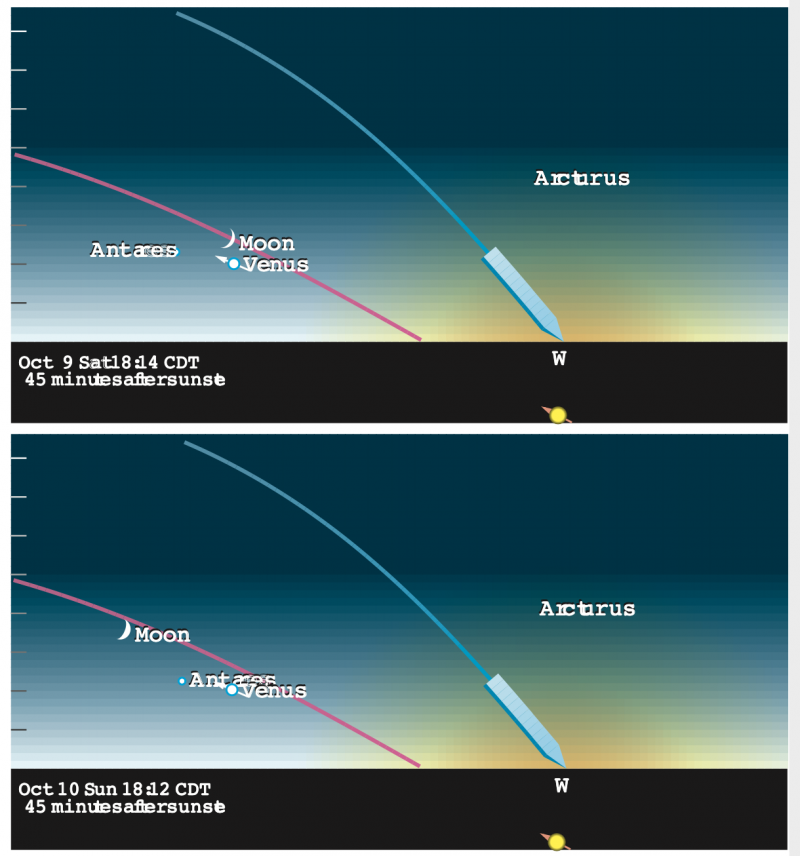
Moon and Venus in October 2021
The brightest planet, Venus, has been in the west after sunset for some months. Now, one of northern summer’s most beloved stars, Antares in the constellation Scorpius the Scorpion, is near Venus in the western twilight. And, beginning around October 7, 2021 – or perhaps more realistically for Northern Hemisphere viewers, October 8 – you will see the young moon return to the evening sky to sweep past Venus over several evenings. Their exact conjunction will take place on October 9 around 19:00 UTC. That’s when Venus and the moon will have the same right ascension (comparable to earthly longitude) on the sky’s dome. But don’t let that date or time worry you. Watch for the moon and Venus on all of these evenings. Just be sure to catch them soon after sunset. They’ll quickly follow the sun below the western horizon.
All these objects are easily bright enough to withstand the glow of evening twilight. But, for us in the Northern Hemisphere, the difficulty in seeing the moon, Venus and Antares in October 2021 will be the narrow autumn angle of the ecliptic. The ecliptic is the sun’s path in our sky. The moon and planets travel along it, too. As seen from northerly latitudes, the ecliptic lies near the horizon in the evening twilight sky. And thus the moon, Venus and Antares will appear well to one side of the sunset point (to the left of the sunset point, as you stand facing west).
From the Southern Hemisphere, the season is reversed. It’s spring in that hemisphere now, and the springtime ecliptic makes a steep angle with the horizon in the evening. The Southern Hemisphere will have a glorious view of the moon and Venus on October 7, 8, 9 and 10.
After about October 10, the moon will have waxed to a fat crescent in the evening sky. First quarter moon will come on October 12 by clocks in North America (October 13 at 03:25 UTC). And the full moon will come on October 20.
Meanwhile, keep watching the western skies for Venus and Antares. They’ll have their own conjunction (when they’ll be closest in right ascension) on October 16. Afterwards, Antares will slip into the sunset glare to be gone for another season. But Venus will continue to increase its distance from the sunset (still moving mostly sideways, to the left of the sunset point, as seen from our northerly latitudes). Venus will finally reach the end of its tether with respect to the sun on October 29. Astronomers call this event a greatest elongation of Venus.
Sneak peak of new charts from Guy Ottewell
By the way, if you’ve been following EarthSky, you know how much we value the chart-making skills of Guy Ottewell in the U.K. See some examples of Guy’s charts at EarthSky here. He’s just now developing a new set of charts for each month, which he calls pairs diagrams, showing the 10 best views in the morning and evening sky each month. Below are Guy’s pairs diagrams for the sweep of the moon past Venus and Antares on October 7 to 10. Watch for his pairs diagrams in 2022! And see more of Guy’s work at UniversalWorkshop.


Bottom line: The young moon and Venus will be near each other in the sky from about October 7 to 10, 2021. The Southern Hemisphere has the best view!











